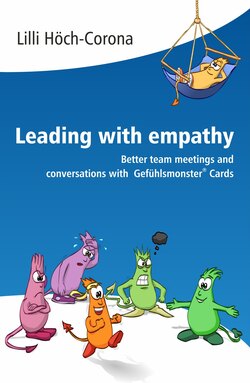Читать книгу Leading with empathy - Lilli Höch-Corona - Страница 9
На сайте Литреса книга снята с продажи.
ОглавлениеTEAM
Tool 1: Warm Up
Best Practice
Chantal Meunier holds a workshop with her team leaders to discuss the effects of introducing a new process and to explore them. To start, she chooses to do an entry round with the Gefühlsmonsters with the question how the team leaders are doing with the new process. Everyone walks around, stops at the card of their choice and explains it in one sentence.
The following picture emerges:
She now knows that the majority of team leaders are open to the process and who is still uncertain or worried about it. This way she feels well prepared for the following conversation.
Occasion
• For workshops, trainings, retreats.
• If you want to activate the participants at the beginning of the event.
• If you want to find out possible resistance right at the beginning of the event.
Goal
• You will receive a mood picture right at the beginning.
• In a short time you will receive information about which participants are motivated, who has concerns about the event or whose attention level is limited due to tiredness or stress.
• You increase the attention for the subsequent topic of the event.
Duration
30–60 minutes, depending on the number of participants
Materials
Gefühlsmonster® Cards medium (or extra-large for larger group option)
How it works
The cards are laid out in a circle in the middle and all participants express how they feel about the start of the event.
First think about what you want to ask. Possible questions are:
a) How are you feeling in general?
b) How do you feel here at the event today?
c) How do you feel about our topic today?
Then place a circle of the medium cards in the middle of the room.
Short introductory speech for this method:
"You see here 25 cards with representations of feelings, called Gefühlsmonsters. Emotions are contagious. If you look carefully while wandering around, you will feel a slight resonance in some cards. These figures may have something to do with how you feel right now. That's exactly what I want to ask you: … (Here you ask your chosen question a, b or c.) At these cards you stop and think for a moment about what the card means to you. Choose a maximum of three cards which you would like to say something about. Please memorize the numbers of these cards. Then I will ask you to show the cards you have chosen one after the other and to comment on them.”
All participants now walk around the cards and choose 1–3 cards, memorize the numbers and sit down again. Then the first participant starts, picks up the chosen card(s), says what the card means to them, puts it down again and sits down. Then it is the next one's turn until the whole group has spoken.
Impact
• Focused attention in the group due to the highly structured process.
• Participants who are prevented from paying attention to the event by other circumstances (for example, because of other day-to-day problems) or simply by unpleasant feelings have the opportunity to state this at the beginning. This subsequently helps them to focus on the event.
Option for larger groups and sufficient space
Spread out the extra-large cards on the floor.1 Invite the participants to walk around the room, going from card to card and standing on or next to the card they want to choose. The physical change of place helps to get moving mentally as well.
Small groups are likely to form around individual cards and some participants will stand alone at a card. Decide,
a) whether you walk from card to card and interview those standing there about what the card means to them (for quiet, more disciplined groups)
b) whether you ask the participants to discuss the meaning of the card with the people they meet at a card. You might ask people standing alone at one card to join one of the groups for the exchange or to get together with other individuals.
Afterwards, a speaker for each group reports what has been discussed, and the individuals speak for themselves.
Options of possible questions
• How are you doing with project XY (topic of the event/team meeting)?
• How would you like to feel about project XY?
• Which Gefühlsmonsters can accompany you at this event today so that it will be a good event for you?2
• Possible follow-up question: What can you contribute to make you feel with project XY as desired? (Possibly have it written on moderation cards)
Further options of questions (solution-oriented)3:
• How are you doing at the moment? Which moods correspond to you at the beginning? (1–3 cards)
• In which mood(s) would you like to go home tonight/would you like to be at the end of the day?" Or: "How would you like the mood in the team to be after the day?" (1–3 cards)
Afterwards the following transition offers itself for team days: "Which topics would we have to talk about today, so that it becomes more probable to make these feelings possible?"
1 The non-laminated cards are suitable for putting them on the floor, too, since they are protected by cellophane wrapping.
2 Thank you Thomas Fehr (www.inveni-co.de) for this question.
3 Thanks to Rita Wawrzinek (www.fiberlin.de) for this suggestion!
